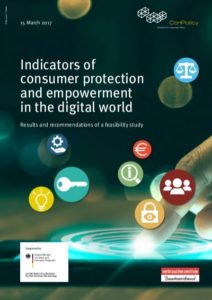.
 There is no doubt about it: digitalization is transforming society. From the way we communicate with each other to the way we shop for clothes, a dependency on technology has increased innovation, choices, and competition. However, while this technological dependency holds a boon of future capability for the international community, over one half of the global population still does not have access to the internet. Of the many consumers who do use the Internet,
There is no doubt about it: digitalization is transforming society. From the way we communicate with each other to the way we shop for clothes, a dependency on technology has increased innovation, choices, and competition. However, while this technological dependency holds a boon of future capability for the international community, over one half of the global population still does not have access to the internet. Of the many consumers who do use the Internet,
- 46% don’t trust their governments to protect their rights online,
- 72% percent are concerned that too much of their data is being collected online, and
- 68% are worried their digital payments are unsafe.
- To close the digital gap by expanding broadband access
- To improve the quality of the access
- To develop skills and competences relevant to the digital world
- To strengthen confidence and trust in the digital market
- Access to the Internet, information and communication technologies/services (ICT) and consumer trust in these products/services are all vital for comprehensive and successful digitalization process.
- Privacy, data security, digital literacy have brought the demand-side of ICT into the public eye, holding the industry more accountable and encouraging increased trust.
- The United Nations Guidelines for Consumer Protection (UNGCP) should be used as a policy framework to protect consumers digitally.
- Quantitative means to measure and improve the digital consumer's protection and empowerment must be developed.
- These indicators can be derived from UNGCP, which lists 65 indicators divided into 8 categories.
- Indicators and data must be developed to fill in the gaps for economic interest, product safety/liability, and information transparency.
- Simple representative consumer surveys can be used in the short-term to generate periodic data that can fill in these gaps.
- Along with other initiatives, there needs to be an assessment that evaluates the consumer’s protection and empowerment in the digital world for the long-term. A four-step procedure is offered: Arrange a G20 group to agree on an overall framework. An international organization should develop indicators and test methods. The indicators already employed should be further studied and refined. A G20 committee should approve a draft list of indicators and the institution should periodically collect data on the indicators.
The views presented in this article are the author’s own and do not necessarily represent the views of any other organization.


a global affairs media network
Indicators of Consumer Protection and Empowerment in the Digital World

|
May 15, 2017
 There is no doubt about it: digitalization is transforming society. From the way we communicate with each other to the way we shop for clothes, a dependency on technology has increased innovation, choices, and competition. However, while this technological dependency holds a boon of future capability for the international community, over one half of the global population still does not have access to the internet. Of the many consumers who do use the Internet,
There is no doubt about it: digitalization is transforming society. From the way we communicate with each other to the way we shop for clothes, a dependency on technology has increased innovation, choices, and competition. However, while this technological dependency holds a boon of future capability for the international community, over one half of the global population still does not have access to the internet. Of the many consumers who do use the Internet,
- 46% don’t trust their governments to protect their rights online,
- 72% percent are concerned that too much of their data is being collected online, and
- 68% are worried their digital payments are unsafe.
- To close the digital gap by expanding broadband access
- To improve the quality of the access
- To develop skills and competences relevant to the digital world
- To strengthen confidence and trust in the digital market
- Access to the Internet, information and communication technologies/services (ICT) and consumer trust in these products/services are all vital for comprehensive and successful digitalization process.
- Privacy, data security, digital literacy have brought the demand-side of ICT into the public eye, holding the industry more accountable and encouraging increased trust.
- The United Nations Guidelines for Consumer Protection (UNGCP) should be used as a policy framework to protect consumers digitally.
- Quantitative means to measure and improve the digital consumer's protection and empowerment must be developed.
- These indicators can be derived from UNGCP, which lists 65 indicators divided into 8 categories.
- Indicators and data must be developed to fill in the gaps for economic interest, product safety/liability, and information transparency.
- Simple representative consumer surveys can be used in the short-term to generate periodic data that can fill in these gaps.
- Along with other initiatives, there needs to be an assessment that evaluates the consumer’s protection and empowerment in the digital world for the long-term. A four-step procedure is offered: Arrange a G20 group to agree on an overall framework. An international organization should develop indicators and test methods. The indicators already employed should be further studied and refined. A G20 committee should approve a draft list of indicators and the institution should periodically collect data on the indicators.
The views presented in this article are the author’s own and do not necessarily represent the views of any other organization.


